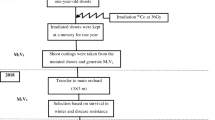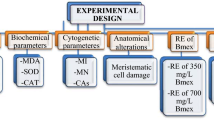Abstract
THE mutagenicity of mesyloxy esters of differing chemical structure has been studied in Drosophila, and the marked differences observed have been attributed to differences in the reactive alkyl group and the non-alkylating “prosthetic” parts of the compounds1. Relationships between the chemical structure and the biological effects of different monomesylates have also been studied in barley2. Although the qualitative and the quantitative differences in the biological effects, including chromosome breakage and mutation rates, produced by this group of compounds have been attributed to a correlation between structure and activity, very little attention has been paid to the physical factors which may influence the reactivity. By “physical” we mean such factors as temperature and hydrogen ion concentration of the treatment solutions, which may influence the reactivity, functionality, stability and the rate of diffusion of a chemical, and which in turn may modify its biological effects. We have therefore studied the modifying effects in barley of temperature and hydrogen ion concentration on various biological effects produced by the three mesyloxy esters—ethyl methane-sulphonate (EMS), methyl methane-sulphonate (MMS) and 1,4-dimethylsulphonoxybutane (myleran). The compounds have different reactive alkyl groups. The present report summarizes data relating to the effect of temperature and pH on the frequency of chromosome breakage in somatic cells and on chlorophyll mutation rates induced in barley by the three chemicals.
This is a preview of subscription content, access via your institution
Access options
Subscribe to this journal
Receive 51 print issues and online access
$199.00 per year
only $3.90 per issue
Buy this article
- Purchase on Springer Link
- Instant access to full article PDF
Prices may be subject to local taxes which are calculated during checkout
Similar content being viewed by others
References
Fahmy, O. G., and Fahmy, M. J., Genetics, 46, 1111 (1961).
Rao, R. N., and Natarajan, A. T., Mutation Res., 2, 132 (1965).
Ramanna, M. S., and Natarajan, A. T., Ind. J. Genet., 25, 24 (1965).
Author information
Authors and Affiliations
Rights and permissions
About this article
Cite this article
NATARAJAN, A., RAMANNA, M. Modification of Relative Mutagenic Efficiency in Barley of Mesyloxy Esters by Different Treatments. Nature 211, 1099–1100 (1966). https://doi.org/10.1038/2111099b0
Issue Date:
DOI: https://doi.org/10.1038/2111099b0
Comments
By submitting a comment you agree to abide by our Terms and Community Guidelines. If you find something abusive or that does not comply with our terms or guidelines please flag it as inappropriate.



